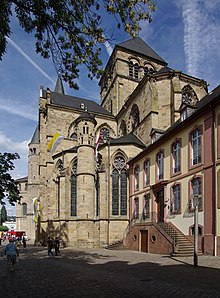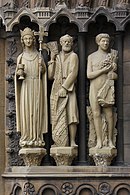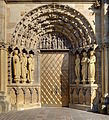Liebfrauenkirche (Trier)
| Church of Our Lady | |
|---|---|
| Denomination : | Roman Catholic |
| Patronage : | Dear women |
| Rank: | Basilica minor |
| Cathedral Chapter : | Hans Wilhelm Ehlen |
| Parish : | Dear women |
| Address: | Liebfrauenstrasse 2 54290 Trier |
Coordinates: 49 ° 45 '21 " N , 6 ° 38' 35" E The Church of Our Lady in Trier is located right next to the Trier Cathedral in the center of the city. Together with the Elisabeth Church in Marburg, it is the oldest Gothic church in Germany and the most important and earliest Gothic central building in the country.
The Church of Our Lady has been part of the UNESCO World Heritage Site of Roman Monuments, Cathedral and Church of Our Lady in Trier since 1986 .
history
Origin and Middle Ages
After the ancient double church complex from the time of Emperor Constantine the Great had to be demolished after a thousand years due to dilapidation, Archbishop Theoderich von Wied began building the church. The foundations of the previous church were partially used. The exact date of the start of construction can no longer be determined, a painted (later created) inscription inside on a column reads: “The construction of this church began in 1227 and ended in 1243”, but today there is talk of a start of construction 1230 off. The construction was architect and artists from Champagne and Ile de France participates of the 13th century prevail. This brought the Gothic into effect, the dominant architectural idea of the time, which was already highly developed in France. The building is one of the earliest German examples of Gothic and is also one of the rare central buildings of this time. The floor plan is based on squares from which only the choir protrudes and which are surrounded by eight chapels. Twelve pillars support the building, symbol of the twelve apostles
Half of it was completed by around 1243, but then the Liebfrauen chapter ran out of funds. This could be related to the death of Archbishop Theodoric, since he is to be regarded as a sponsor. Only after a collection in the diocese of Cologne in 1243, approved by Archbishop Konrad von Hochstaden and favored in a letter of indulgence , could the construction of the Church of Our Lady be continued. In this document the church is referred to as the “mother church” of all churches in the Trier province. The construction was probably finished around 1260. In 1492 was on the central tower a bit high placed, because of their high technical and craft completion degree as Daedali arte (with the art of Daedalus was) called. The tall peak can be seen in ancient cityscapes, but was destroyed in a storm on Visitation Day (July 2nd) in 1631. A hipped roof was placed on top, which burned in the Second World War . A new one was able to be put on as early as 1945, the steel roof structure of which was rebuilt in 2003 so that it corresponds to the pre-war state.
The rich figural decorations on the west facade and especially the west portal can probably be dated to the time of origin in the middle of the 13th century. The tympanum shows the enthroned Madonna with the baby Jesus in the middle, her feet on the dragon symbolizing evil. On the left of the picture on their right, the three wise men, the wise men from the Orient, pay homage to the child, and on the far left are the shepherds who were the first to learn about the birth of the Savior. The scenes on the right show the presentation of Jesus in the temple and the murder of children in Bethlehem. The arches contain figures of angels with liturgical implements, above them figures of bishops, church teachers, music-making kings and figures of the wise and foolish virgins from the wedding and judgment parable of the Gospel ( Mt 25 : 1–13 EU ).
Perhaps the most appealing work of art inside the church is a Madonna and Child enthroned in the last chapel on the left to the east. It is a carved wooden sculpture from the mid-14th century on a neo-Gothic altar. It is said to come from the Ahrweiler area.
The Liebfrauenkirche was used by the members of the cathedral chapter to read their daily mass and also served them as a burial church . As a result, it was literally overloaded with graves over the centuries. Most of these graves were removed during the French Revolution. A number of important grave monuments have been preserved in the church to this day, others such as the tomb of Archbishop Jakob I von Sierck or the cathedral dean Christoph von Rheineck are now in Trier's museums.
19th century
After Trier was occupied by the French revolutionary troops in 1794, Liebfrauen was separated from the cathedral in terms of organization and liturgy in 1803. Before that there was a close relationship between the cathedral and Liebfrauen. In the course of a year, numerous processions led from the cathedral into the Liebfrauenkirche; there is also a passage that connects the two churches. According to Trier tradition, the Liebfrauenkirche was supposed to be demolished, but on the occasion of his visit to Trier , the Trier mayor led Napoleon to the balcony of the Palais Kesselstadt opposite and said to him: “Sire, you don't want to tear down the masterpiece of a French architect”. In any case, the nearby church of St. Laurentius, which was located directly at the Basilica of Constantine , was torn down and the parish was named "Our Lady and St. Laurence". As an outward sign of the separation, the portal between the paradise used by the cathedral and the Liebfrauen was walled up on the side of the cathedral and the paradise was used as a sacristy for the Liebfrauen. On the occasion of the Heilig-Rock-Pilgrimage in 1959, the portal was opened again, then closed with a board door and, after the cathedral restoration, provided with a new wooden portal so that it can be used again today.
An extensive restoration took place from 1859 with interruptions until the 1890s. The aim was to restore the church to its medieval state as much as possible. Accordingly, some baroque furnishings were replaced by neo-Gothic pieces, including a high altar designed by the Cologne cathedral builder Vinzenz Statz and above it two altar paintings by the history painters Bruno Ehrich and Wilhelm Döring . A neo-Gothic organ gallery was installed above the west portal and the windows were given new, colored glazing.
After the Second World War
The Liebfrauenkirche suffered severe destruction during the Second World War and was restored from 1946 to 1951. In addition to the roofs, large parts of the masonry, the window tracery and many sculptures on the exterior had to be renewed; During the restoration work, a carved floor plan from the time the church was built was discovered in one of the stair towers. The design with the central location of the altar, realized after an architectural competition, was planned by the architect Rudolf Schwarz and anticipated the guidelines of the Second Vatican Council . In the course of the redesign, some pieces of equipment from the 19th and early 20th centuries that were still preserved after the war had been destroyed, e.g. B. the high altar. To replace the destroyed glass windows from the 1860s, new ones based on a design by Jacques Le Chevallier and Alois Stettner were used.
The Church of Our Lady received the Basilica minor award from the Pope in 1951 . The reason for this was the redesign of the chancel after the war, when the altar was placed in the middle of the church. In 1986 the church, together with the Trier Cathedral and the Roman cultural monuments in Trier and the surrounding area, were included in the UNESCO World Heritage List .
In 1992 the sculptures of the west portal, which are now in the museum's possession, could be put back in their old location as casts; the long-lost pieces were replaced by new creations by the sculptors Theo Heiermann , Elmar Hillebrand and Guy Charlier. On the left garment next to Peter and Adam stands Ecclesia , a medieval allegorical figure with the cross as a symbol of Christianity and the chalice as a symbol of the new covenant . Synagogue, the figure opposite her, embodies the former attitude towards Judaism. Blindfolded, she turns away from John and his gospel. In her right hand she holds the tablets of the law, in her left a broken scepter as a sign of the supremacy of Christianity. Heiermann's new statue of Peter does not have the usual keys as an attribute, but a fishing net, according to the Gospel of Luke ( Luke 5 : 6-10 EU ). A committee was responsible for the design of the new sculptures, bringing the most diverse and precise requests to the artists. In the development phase of the Eva figure by Charlier, there were, for example, objections to the nose, which one of the members seemed a bit too pointed, the buttocks should be more delicate and the hair falling over the shoulder should be made smoother.
After more than three years of extensive restoration between July 2008 and September 2011, the Liebfrauenkirche was reopened on September 4, 2011. During the restoration, the original color scheme of the interior could be determined; it was reconstructed on a window axis in one of the chapels for demonstration purposes. The important pieces of equipment from the 17th to 20th centuries, some of which still showed damage from the war, were carefully repaired. Small changes were made to the altar island by the widow of the architect Rudolf Schwarz, Maria Schwarz . The new glass windows in the so-called paradise were designed in 2011 by the Soest artist Jochem Poensgen .
organ
Until the Second World War, an organ from 1843, which was built by the organ builder Heinrich Wilhelm Breidenfeld , stood on a neo-Gothic gallery above the west portal in the Liebfrauenkirche . The instrument had 32 stops on two manuals and a pedal . This instrument was so badly damaged during World War II that it could no longer be repaired. After the end of the war, planning began for a new organ system for which a new location had to be found, as the neo-Gothic gallery had been removed when the church was being restored. A main organ was planned on the south side of the church, on the ground floor, as a multi-storey instrument, and a two-part choir organ. The main organ was not completed, only parts of the substructure were carried out and stood unfinished in the church for decades until they were dismantled during the last restoration of the Church of Our Lady. But the intended choir organ could only be partially implemented: It was inaugurated in 1951 with 15 stops on two manuals and pedal (cone chest). The free-standing console, however, was already laid out with three manuals in order to be able to connect the planned main organ. In the course of the interior renovation in 2011, the organ was restored and received a two-manual console. This is now connected to the two-part organ via the church's internal network and can therefore be set up in different places in the church.
|
|
|
|||||||||||||||||||||||||||||||||||||||||||||||||||||||||||||||||||||||||||||||||||||||||||
-
Pairing :
- Normal coupling: II / I, I / P, II / P
- Sub-octave coupling: II / I, II / II
- Playing aids : II. Equallage Ab, register fetter
Bells
A short time after Trier Cathedral received its new bell in 1951, the Otto bell foundry from Bremen-Hemelingen cast a four-part bronze bell ring for the Church of Our Lady. The bells have the following chimes: a ′ - h ′ - cis ′ ′ - e ′ ′. The diameters are: 943 mm, 840 mm, 748 mm, 629 mm. They weigh 510 kg, 360 kg, 260 kg, 160 kg.
see more
Anna herself three inside
Tomb of Karl von Metternich by Mathias Rauchmiller
Main portal ( Wyttenbach , 1835)
See also
literature
- Heinz Brubach and Martin Persch (eds.): 200 years of the Liebfrauen parish in Trier. Trier 2003, ISBN 3-7902-0182-0 .
- Hans Wilhelm Ehlen (ed.): "Let the rose bloom again ..." Festschrift for the reopening of the Liebfrauen Basilica in Trier. Trier 2011, ISBN 978-3-7902-1812-1 .
- Andreas Tacke and Stefan Heinz (eds.); Rita Heyen (photography): Liebfrauen in Trier. Architecture and furnishings from the Gothic to the present day. Petersberg 2016, ISBN 978-3-86568-890-3 .
Web links
Individual evidence
- ^ Parish church of the parish of Liebfrauen. Retrieved June 9, 2013 .
- ^ A b Franz Ronig: The Liebfrauen-Basilia zu Trier . Edited by the Catholic Parish of Our Dear Women and St. Laurentius, Trier 1978.
- ↑ The history painters B. Ehrich and W. Döring themselves have erected a new monument to their artistic work in the motherhouse of the Borromean women in Trier. There are two altarpieces above the high altar, ... , in Düsseldorfer Volksblatt (No. 310) from November 15, 1899
- ↑ Andreas Tacke: Daring Modernity. The walls of the west portal by Guy Charlier, Theo Heiermann and Elmar Hillebrand . Retrieved May 3, 2020.
- ^ Gerhard Reinhold: Otto bells - family and company history of the bell foundry dynasty Otto . Self-published, Essen 2019, ISBN 978-3-00-063109-2 , p. 588, here in particular pp. 365, 550 .
- ↑ Gerhard Reinhold: Church bells - Christian world cultural heritage, illustrated using the example of the bell founder Otto, Hemelingen / Bremen . Nijmegen / NL 2019, p. 556, here in particular 326, 506 , urn : nbn: nl: ui: 22-2066 / 204770 (dissertation at Radboud Universiteit Nijmegen).




















